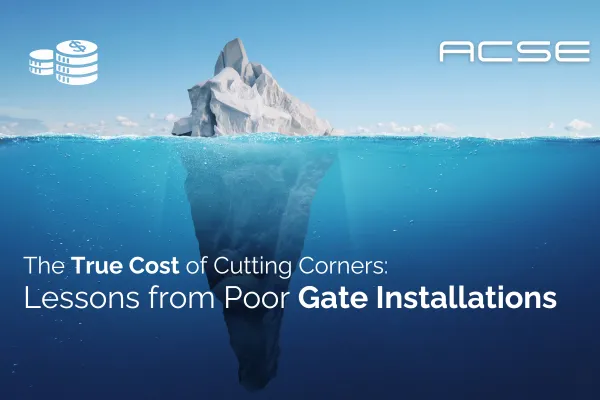
The True Cost of Cutting Corners: Lessons from Poor Gate Installations
When it comes to automated gates, many property owners initially prioritize price over performance, opting for cheaper installation options or skipping essential safety features. But in access control systems, cutting corners comes at a price, one that can far exceed the upfront savings.
This article explores the real-world consequences of poor gate installations, highlighting financial, legal, and safety risks. We’ll also examine how to avoid these costly mistakes by working with certified professionals and choosing code-compliant solutions.
Hidden Costs of Low-Budget Gate Installations
Poorly executed installations might save money initially, but they often come with long-term financial consequences:
Frequent Repairs: Inexpensive components tend to fail more quickly, leading to recurrent maintenance bills and downtime.
Shorter Lifespan: Subpar installation practices reduce the system’s durability, requiring premature replacements.
Code Violations: Non-compliant systems may need to be completely retrofitted to meet UL 325 or ASTM F2200 standards.
The result? What started as a “cheap” project often ends up costing double or triple in the long run.
Real-Life Consequences: Safety and Liability
Beyond cost, the most significant risks involve safety:
Entrapment Accidents: Gates without proper safety sensors can cause serious injury or death.
Vehicle Damage: Misaligned or delayed gate responses can strike passing cars, leading to costly claims.
Legal Repercussions: Injuries or code violations can result in lawsuits, insurance penalties, and even forced shutdowns.
In one documented case, a business owner faced a six-figure liability claim after a delivery driver was injured by a gate lacking entrapment protection.
Common Shortcuts and Their Consequences
Let’s look at shortcuts often taken and the dangers they present:
Skipping Site Assessment: Not evaluating the slope, clearance, and traffic patterns can cause operational failures.
Improper Gate Sizing: Undersized motors or frames can lead to mechanical stress and early system breakdowns.
DIY Installations: Without proper training, DIY efforts often overlook critical safety zones and fail to follow electrical codes.
Inadequate Entrapment Protection: Using only one method of detection (or none at all) puts lives at risk and violates UL 325.
These decisions compromise performance, violate codes, and endanger lives.
The Importance of Certified Installers
Certified installers ensure that:
Site-specific assessments are done prior to equipment selection.
Only UL-listed components are used.
Gates are properly integrated with access control and emergency features.
Installation adheres to local and national codes, including UL 325 and ASTM F2200.
They also educate the client about maintenance schedules and required inspections—an essential part of long-term safety.
Lessons from Retrofitting Failures
Properties that skipped proper planning often face expensive retrofits later:
Replacing incompatible motors or wiring
Reinstalling gate arms to match slope or layout
Upgrading control boards or safety sensors to meet code
These updates can cost 40–60% more than doing it right from the beginning.
When Saving Money Becomes a Liability
It’s important for property owners to understand the risks of hiring unqualified installers:
Uninsured Contractors: Damage or injury can fall back on the owner.
No Warranties: If the system fails, there’s no guarantee of support or repair.
No Compliance Documentation: Future inspections or insurance claims could be jeopardized.
Saving upfront is rarely worth risking future financial and legal troubles.
How ACSE-Certified Professionals Prevent These Problems
Working with ACSE-qualified professionals offers peace of mind:
Thorough pre-installation planning
Selection of compliant and appropriate equipment
Integration of reliable safety devices
Long-term support for maintenance and compliance
Clients also benefit from working with professionals who stay current with changing codes, emerging technologies, and best practices in the field.
A Smarter Approach to Gate Installation
Here’s how to ensure your investment is safe and long-lasting:
Always request a formal site assessment before choosing a gate type.
Ask for proof of certification, insurance, and past work.
Review the design for safety features like sensors and manual release options.
Request written documentation for compliance with UL 325 and ASTM F2200.
Schedule regular maintenance to catch issues early.
Doing it right the first time is not just good practice, it’s a responsibility.
To learn more or schedule a consultation with our design and installation team, send us an email at [email protected].

